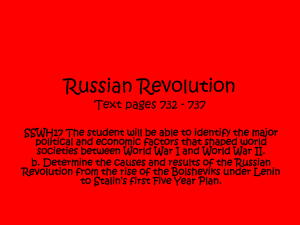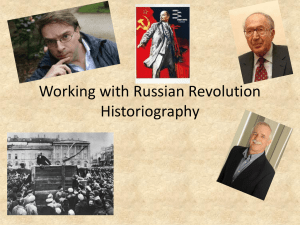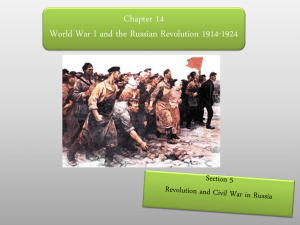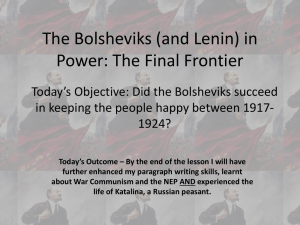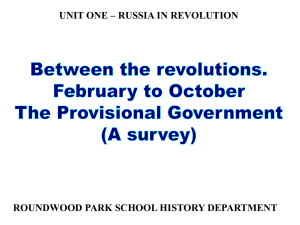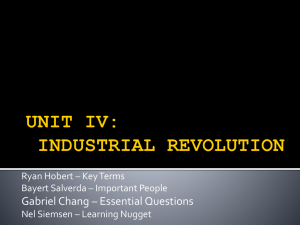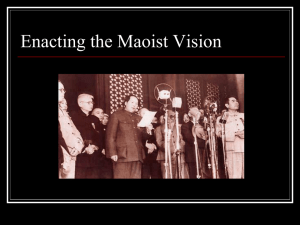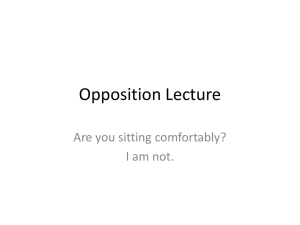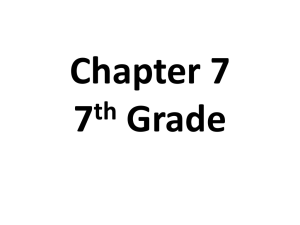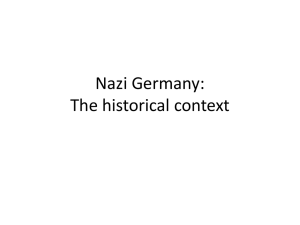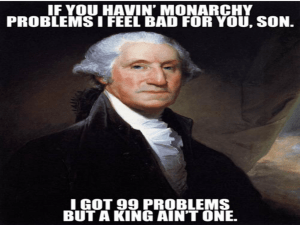Russian Historiography AOS 1 - L Cashman
advertisement
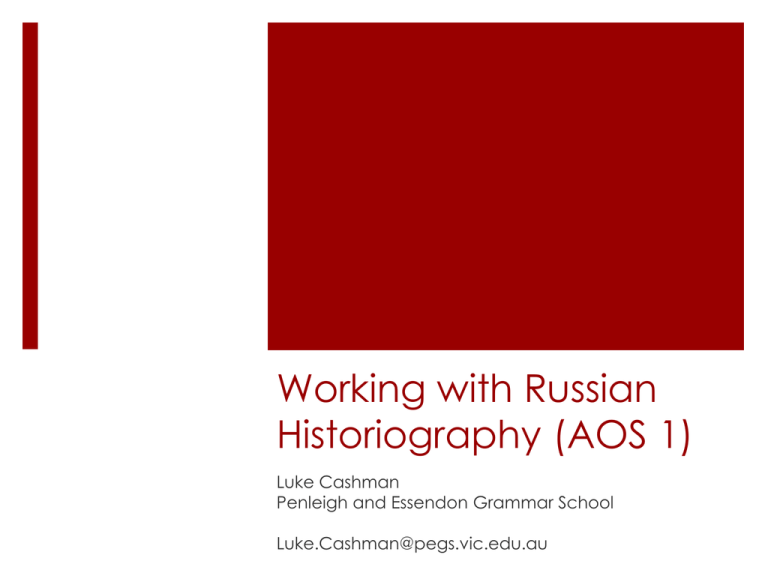
Working with Russian Historiography (AOS 1) Luke Cashman Penleigh and Essendon Grammar School Luke.Cashman@pegs.vic.edu.au What will be covered today? What is historiography? Why study it as part of the Revolutions course? The main historiographical schools and their key exponents Relevant topics in the Study Design Incorporating historiography into SAC and exam responses Where to find historians’ views Crucial resources: Edward Acton, Rethinking the Russian Revolution, London: Edward Arnold, 1990. Richard Malone, Analysing the Russian Revolution 2nd ed., Port Melbourne: Cambridge University Press, 2009. What is historiography? The study, comparison and evaluation of historians’ interpretations of the people and events of the past Can be organised into broad “schools” – historians who agree with each other (to a great or lesser extent) or adopt a similar approach in their methodology The schools can reflect broader trends in politics and society (eg the popularity of Marxism, the course and consequences of the Cold War, emerging ideological trends such as feminism and cultural studies) Sometimes there are enormous differences (origins of the February and October revolutions; the popularity of Lenin and the Bolsheviks) Sometimes they are strikingly similar (impact of World War I) Why study historiography? The Study Design (January 2013): Revolutions in history have been reconsidered and debated by historians. The study of a revolution should consider differing perspectives and the reasons why different groups have made different judgments of the history of the revolution. (p131) Historians place differing emphasis on the role of ideas, leaders and movements in the development of the revolution. (p132) Key skills: consider a range of historians’ interpretations. (p132) The VCAA Assessment handbook criteria (VCAA January 2013): “Teachers should develop an assessment task that allows the student to… consider a range of historians’ opinions.” Descriptors (criteria): “Critical analysis and evaluation of historians’ opinions.” The end of year exam and the Assessor’s Report: “Historiography is assessed in Section A, Question 3 and Section B, Question 1 where the instruction is given.” (2012) It’s the most dynamic aspect of History. Historians will never agree with each other. In this sense, History will go on forever. It reminds us that people rarely agree on current issues (climate change, the necessity of a carbon tax, who would make the better prime minister) The historiographical schools Marxist (Soviet, Western and post-Soviet) Western-liberal Revisionist Libertarian* The Marxist view Grounded in the tenets of Marxism and Leninism Revolution is inevitable as a society passes through certain stages until it reaches its apogee (the workers’ socialist paradise) The October Revolution was the greatest event in world history: “Supreme vindication of the general laws of history discovered by Marx.” (Acton, p30) Lenin and the Bolsheviks perfectly articulated, fermented and channeled the unfocused energies of the proletariat into classconscious, political, revolutionary action in 1905, February and October 1917 Exponents: History of the Communist Party of the Soviet Union (Soviet) Leon Trotsky (Soviet) Christopher Hill (Western) E.H. Carr (Western) John Reed (Western) Dmitri Volkogonov (post-Soviet)? Western-liberal “The traditional liberal interpretation has rejected outright every major tenet of the Soviet view.” (Acton, p35) The Russian Revolution was a tragedy that would eventually have global implications & consequences Marxism, Leninism and socialism are deeply flawed ideologies Rejects notions of inevitability in historical causation, and the broad effects of social and economic factors Instead embraces individual choice and action, and the role of accident and happenstance: “There is a strong tendency [in the Western-liberal tradition] to attribute primary causal importance to the actions of political leaders. It is those at the summit who make the decisive moves in history.” (Acton, p36) Deemphasises the role of “the masses” which is seen as “essentially subordinate” to “political leadership.” (Acton, p37) Exponents: Richard Pipes Robert Conquest Michael Lynch Orlando Figes? Dmitri Volkogonov? Revisionists Seek to “revise” the Marxist and Western-liberal viewpoints Sometimes draws the best from both schools; other times forges a new argument “Revisionist work points to an understanding which, while drawing specific features from each school of thought, supersedes them all.” (Acton, p48) Social history; “history from below” (Acton, p45) and the impact of ordinary people on political events How people at the grassroots level influenced political leaders and institutions as much as they were influenced by them Exponents: Sheila Fitzpatrick S.A. Smith Robert Service Edward Acton Orlando Figes? Libertarian Like Western-liberalism, a critique of Marxism, but from a Leftist-anarchist perspective Based on the principle that societies and individuals function to their full potential when there is no economic or political exploitation “The people” are perfectly capable of self-management; there is no need for a dictatorship of the proletariat. For libertarians, “the Bolshevik triumph marked not the fulfillment of but the failure of the revolutionary promise of 1917”. (Acton, p39) The Bolshevik Party snatched power and self-determination from the mass movement of peasants and workers in order to establish a centralised, coercive and elitist regime Exponents: M Brinton G Konrad & I Szelenyi R Gombin P Corrigan The 1905 Revolution All historians concur that the Russo-Japanese War and the Bloody Sunday massacre fatally damaged the prestige and authority of the tsar Marxist: Led by the workers and the Bolshevik Party; the liberalbourgeoisie betrayed the people by accepting the October Manifesto Western-liberal: Liberals took the lead; socialists played little to no role; the regime only gained a breathing spell Revisionist: Broad-based attack on the regime; the workers outpaced the socialist parties; the outcome of 1905 was unsatisfactory for all The Marxist perspective: The Bolsheviks called upon the masses to rise in arms against the tsar and the landlords… The working class headed the struggle of the masses against the autocracy. The Bolshevik slogan of mass political strike had borne fruit. The October general strike revealed the power and might of the proletarian movement and compelled the mortally frightened tsar to issue his Manifesto of October 17, 1905…. Nevertheless, the Manifesto of October 17 was a fraud on the people, a trick of the tsar to gain some sort of respite in which to lull the credulous and to win time to rally his forces and then to strike at the revolution… CPSU, History of the Communist Party of the Soviet Union (Bolsheviks), Honolulu: University Press of the Pacific, 2005 [1939], pp94 - 5. Why did Tsar Nicolas II abdicate? All historians agree that the tsarist regime (government, bureaucracy and infrastructure) was unable to cope with the prolonged demands of World War I Marxist: The Petrograd workers and soldiers, lead by the Bolsheviks Western-liberal: Revolt began at the top and spread to the middle classes; workers and socialist parties played no role in Nicholas’ decision to step down; not inevitable, but highly likely; due more to the sheer incompetence of the regime and Nicholas’ stubborn refusal to implement necessary reforms Revisionist: Tsarism collapsed under pressure from both popular demonstrations and the withdrawal of elite support The Revisionist perspective The February events were complex. The workers had rebelled, and the soldiers had refused to suppress them. But the strikes, demonstrations and mutiny could have been quashed if coercive agencies had kept faith with Nicholas II. There was no popular certitude that the last knell of Romanov power had been tolled. What made the difference, finally, was that the middle-ranking enforcers of order on the streets had lost their will to use violence to maintain the status quo… it was the workers and soldiers and not the politicians, administrators, generals, businessmen and ambassadors who acted. And a revolution requires action, audacious action. Action came in the form of strikes, demonstrations and mutiny in central Petrograd. On 2 March, the bewildered Nicholas II agreed to abdicate. The ultimate pressure had been applied by a group of Duma politicians, who proceeded to form a Provisional Government. It was adherents of the Progressive Block who predominated in the cabinet, and Kadets were its majority. Ministers moved swiftly to promulgate [put into effect legally] civic freedoms of speech, assembly and association and promised to hold elections, with a universal adult franchise, to a Constituent Assembly… The workers with their street demonstrations had brought down Nicholas the Bloody, and yet they stood aside as a ‘bourgeois’ cabinet assumed power. Robert Service, The Russian Revolution 1900 – 1927 3rd ed., New York: Palgrave Macmillan, 1999, pp33 – 6. The July Days Marxist: A spontaneous, poorly conceived uprising led by the ill-educated workers and sailors; the Bolsheviks joined in only after advising against an attempt at seizing power Western-liberal: Staged by the Bolsheviks to preempt the Provisional Government’s decision to send pro-Bolshevik units of the Petrograd garrison to the front Revisionist: Spontaneous act by Petrograd workers and lowerlevel Bolsheviks; Lenin and the Central Committee wavered and only joined in the later stages The Western-liberal perspective No event in the Russian Revolution has been more wilfully lied about than the July 1917 insurrection, the reason being that it was Lenin’s worst blunder, a misjudgement that nearly caused the destruction of the Bolshevik Party: the equivalent of Hitler’s 1923 beer-hall putsch. To absolve themselves of responsibility, the Bolsheviks have gone to unusual lengths to misrepresent the July putsch as a spontaneous demonstration which they sought to direct into peaceful channels. The July 3—5 action was precipitated by the government’s decision to dispatch units of the Petrograd garrison to the front for the anticipated enemy [German] counteroffensive. Inspired primarily by military considerations, this decision was also meant to rid the capital of the units most contaminated by Bolshevik propaganda. To the Bolsheviks the move spelled disaster since it threatened to deprive them of the forces which they intended to use in their next bid for power… Richard Pipes, The Russian Revolution 1899 – 1919, London: The Harvill Press, 1997, p419 – 420. The nature of the Bolshevik Party Marxist: A tight-knit, professional, dedicated revolutionary vanguard of the proletariat as demanded by Lenin in What is to be done? (1902); small; top-down decision-making process; “democratic centralism” (Lenin); perfectly expressed the will of the masses Western-liberal: similar to the Marxist view but a different “flavour”; tightknit and centralised but not reflective of the people’s will. According to Pipes, more of “ein Orden” (an Order) where the leader’s will was implicitly obeyed. They Bolshevik Party was an institutionalised form of Lenin’s personality. Revisionist: A loose organisation that grew rapidly throughout 1917; the new, lower-level members urged the Central Committee to seize power; what counted more was the party’s intransigent position on the far left of Russian politics which became more attractive to the masses as the Provisional Government proved incapable of dealing with the deepening crises of 1917 The Revisionist perspective In 1917 the Bolshevik Party was very different from the tightly knit conspiratorial party advocated by Lenin in 1903 [the year the Russian Social Democratic Party was created]. Though more unified that the SRs, Mensheviks, and anarchists, the Bolsheviks were a diverse lot and even after Lenin’s April Theses became official policy, the gradualist views of Kamenev and G.E. Zinoviev (dubbed ‘Lenin’s mad dog by the Mensheviks) continued to enjoy strong support. Alongside cadres who had endured years of persecution, tens of thousands of workers, soldiers, and sailors flooded into the party, knowing little Marxism, but seeing in the Bolsheviks the most committed defenders of the working class. Bolsheviks were indefatigable in agitating for their policies in factories and on street corners. The result was that party membership rose from perhaps 10,000 in March to nearly 400,000 by October. S.A. Smith, The Russian Revolution: A Very Short Introduction, Oxford: OUP, 2002, p24. October: Coup or popular Revolution? Marxist: Lenin and the Bolsheviks judged the moment perfectly and seized power in the name, and with the support, of the workers, peasants and soldiers of Russia Western-liberal: A classic coup d’etat; the seizure of government authority by a tiny, radical party with neither broad, deep nor lasting popular support. The tacit acceptance of the workers and peasants was not agreement – it was more a sign of indifference or disillusionment Revisionist: The October revolution was carried out by relatively few people, but the millions of Russia were not needed to push over the empty shell of the Provisional Government. The takeover had the widespread support of those who wanted to see power in Russia pass to the soviets. Western-Marxist perspective [I]n these years of trial the Bolsheviks had evolved a political philosophy and analysis of events more realistic than those of any of their rivals was shown by the ease with which they swept aside all other parties in the revolutionary months of 1917… In Russia it was the Bolshevik mastery of fact that was decisive. The party knew exactly what it wanted, what concrete concessions to make to different social groups at any given stage, how to convince the masses of the population by actions, its own and their own. The party’s organisation allowed greater flexibility in manoeuvre, combined with firmness and strength in pursuit of the clearly envisioned ultimate objectives. It was this which won the confidence of a following sufficient to enable the Bolsheviks to seize and retain power whilst the Mensheviks and SRs discredited themselves by the helplessness of their most eloquent phrases in the face of the rude and stubborn fact. Christopher Hill, Lenin and the Russian Revolution, Harmondsworth: Penguin Books, 1971 [1947], p63. Volkogonov on October …the Mensheviks were right when they said in 1917 that Russia was not ripe for socialist revolution. Yet he was prepared to exploit the opportunity for his own party to seize power in October… Lenin therefore leapfrogged the classic Marxist scheme… He recognised that the war had not only been the chief cause of the February revolution which finished off the Russian Empire, but would also dash the hopes that had been aroused by them… [Lenin called] for the defeat of his own country, and for making an already hideous war into something even worse: a nightmare civil war. With the seizure of power in mind, this may have been the logical position to take, but from the moral point of view it was deeply cynical... When the Russian people had been driven to the limit by the war, and state power in effect lay on the streets of the capital, the Bolsheviks obtained power with remarkable ease, in exchange for the promise of peace… The Bolsheviks survived because of their leader and because of their commitment to unbridled force. Dmitri Volkogonov, Lenin: A new biography, New York: The Free Press, 1994, pp67 – 81. Assessment tasks and the exam Teachers can select from a range of four assessment options: 1. 2. 3. 4. Analysis of visual and/or written documents Argumentative essay Research report Historiographical exercise The different tasks make slightly different demands in terms of the use of historiography For 1 and 4, see below For 2 and 3: Introductions and conclusions to set up debates and outline your own contention Topic sentence to introduce ideas and arguments In body paragraphs to present opinions and some evidence not available elsewhere For the exam, analysis and evaluation of historians’ views for Russia AOS 1 is ONLY required in Section B - document analysis (2012 Assessor’s Report) Using historians’ views in your own writing Create a historiography grid (see example) to systematise your knowledge Avoid referring to the schools of thought because they don’t always agree: Figes and Volkogonov are points in case on this matter Specific historians’ views on particular topics If quoting, keep it brief and incorporate into your own writing Paraphrasing is also acceptable, as is putting an historian’s name in brackets How many references to historians’ views? Depends to an extent on the task Don’t attempt to “solve” the Russian Revolution Assessor’s want to see that you can stake out a position in the debate that is backed up by historians’ views and, more importantly, specific historical evidence. Evaluate the extent to which this representation provides a complete depiction of the revolutionary situation in Russia in October 1917. In your response, refer to parts of the representation and to different views of the Revolution. (VCAA exam 2012) The painting by Kochergin presents a fascinating, if somewhat fanciful, depiction of the events surrounding the Bolshevik seizure of power in October 1917. He presents the storming of the Winter Palace as an event of great heroism and struggle, as exemplified by the pose of the anonymous Red Guard in the very centre of the image and the battered gates behind him. In a typical display of Soviet propaganda, it implies that the Provisional Government was toppled by an anonymous mass of workers, soldiers and sailors. While British Marxist Christopher Hill would agree with such a depiction of October, the actual storming of the palace was much less dramatic and something of a non-event. No one, it seemed, was willing to stand up for the Provisional Government (Trotsky). Pipes, however, seeks to undermine the popular legitimacy of the Bolshevik regime by arguing that October was little more than “a classic coup d’etat… with hardly any mass involvement.” Revisionists like Fitzpatrick and Service dispute this view by noting that, as Fitzpatrick writes, “the Bolsheviks’ greatest strength… was the party’s stance of intransigent radicalism.” This made the Bolsheviks by far the most popular political alternative, at least in the industrial centres of Petrograd and Moscow. The image also does little to explain the role of Trotsky, as head of the three-man MRC, in personally planning and staging the October Revolution. Trotsky himself argued that his, and Lenin’s, presence in Petrograd was vital to the success of the Revolution, while Ian D. Thatcher emphasises Trotsky’s preference to seize power in the name of the soviets rather than the Party, which was ultimately more popular. Therefore, while this painting emphasises the role played by the ordinary people of Petrograd in the October Revolution, it places too much importance on them and not enough on the determination and organisation of revolutionary leaders like Lenin and Trotsky. (312 words) Resources: VCE History Study Design: http://www.vcaa.vic.edu.au/Documents/vce/history/history-sd.pdf VCE History: Revolutions Assessment Handbook: http://www.vcaa.vic.edu.au/Pages/vce/studies/history/revolutions/revolutioni ndex.aspx Past VCAA exams and assessor’s reports: http://www.vcaa.vic.edu.au/Pages/vce/studies/history/revolutions/exams.as px Textbooks: Richard Malone, Analysing the Russian Revolution, 2nd ed. Perfect, Ryan & Sweeny, Reinventing Russia. Michael Lynch, Reaction and Revolution: Russia 1894 – 1924. Bibliography – see final page of this booklet Final thoughts As more and more work is done in Russian archives, the more we will learn about this fascinating country and its past. The historiography of Russia is alive and well! It’s an ever evolving beast that will never provide “the” answer Instead… demonstrate your familiarity with the scope of the debate and, perhaps, choose an historian whose ideas/arguments you admire and/or agree with. Then back up that line of thinking with historical evidence and specific examples. Read read read; write write write
